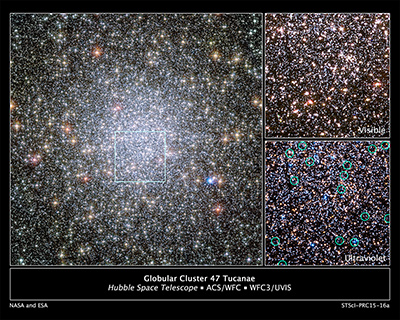Observations of white dwarfs in a densely populated globular cluster confirm astronomers’ expectations that stars migrate to a cluster’s outskirts after losing weight.

Gravity has everything to do with the way stars interact with one another, and the stars in globular clusters are no exception. Globular clusters are groups of very old stars bound together in a sphere. They organize their stars by mass, with heavier, slower stars congregated near the middle, and lighter, faster ones at the cluster’s edge.
Dynamical relaxation is the process by which clusters organize themselves in this way, and it is also the process that reorganizes stars when any mass changes occur. Some stars do not have static mass, and when they lose weight, the gravity in the cluster will propel them outward.
White dwarfs are one type of low-mass star that is found in the outer reaches of a cluster. They began as the cores of stars like the Sun. When the stars hit the end of their fusion-powered lives, they shrug off their outer layers to reveal the collapsed, planet-size core at their hearts. The process by which a star reaches this white dwarf stage causes it to lose a large portion of its mass — about 40%—in the form of stellar winds.
Before losing this mass, the star is situated near the center of the cluster alongside other massive objects. But then, after becoming a smaller white dwarf, it migrates to a new position via gravitational interactions with other stars, that is relative to its new weight. This mass-loss process and movement makes white dwarfs a great subject for observing dynamical relaxation, yet until now we haven’t caught this migration in action.
Using Hubble’s Wide Field Camera 3 — which has the ability to catch ultraviolet light that is dispersed by Earth’s atmosphere and therefore invisible to ground-based telescopes — Dr. Jeremy Heyl (University of British Columbia, Canada) and colleagues studied white dwarf stars in the globular cluster 47 Tucanae.
This cluster is a rich agglomeration of stars in the Southern Hemisphere sky and a frequent research target, but it hasn’t been analyzed in this particular way before. Because white dwarfs cool as they age, and because hotter (younger) white dwarfs are brighter in ultraviolet wavelengths than cooler (older) ones, the researchers were able to estimate the ages of the cluster’s stars and identify two major populations of white dwarfs.
One population was a group of relatively new white dwarfs, only a few million years old, and the other a very old, 100 million-year-old group. Heyl and colleagues examined the location of the stars in each age category and found that the younger ones were gathered near the center of the cluster, while the older ones were dispersed at the outer edges.
This result is just what they expected to find.
Since stars expel the most mass in the stage immediately prior to becoming a white dwarf (the so-called asymptotic giant branch, or AGB, stage), it follows that those stars that recently became white dwarfs would still be hanging around the center of the cluster, not having had time to begin their migration outward. Similarly, older stars that had more time as smaller entities should have already arrived at their destinations. This observation confirmed not only the presence of dynamical relaxation, but also the theory that stars do indeed lose most of their mass in their AGB phase.
The team didn’t determine whether the white dwarfs also show signs of dynamical relaxation in their motions, but that will be a good focus for follow-up. For now, the analysis is a nice confirmation of what we thought we knew about the mechanics within globular clusters.
 1
1
Comments
ROBERT STENTON
May 29, 2015 at 5:07 pm
It could also be pointed out that the white dwarfs move out by taking kinetic energy away from the larger stars which then migrate towards the center of the cluster.
You must be logged in to post a comment.
You must be logged in to post a comment.